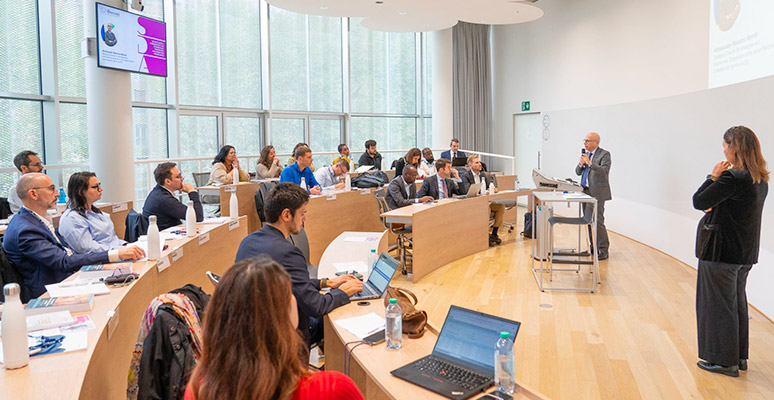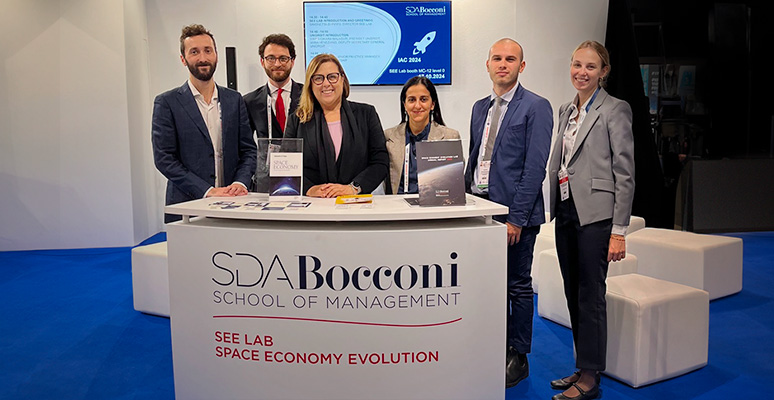
- Start Date
- Duration
- Format
- Language
- 5 may 2025
- 4 days
- Class
- Italian
Offrire le conoscenze e competenze relative all’imprenditorialità sociale e al management del terzo settore per nuovi modelli di business sostenibili.
In the not-too-distant future, the total value of space activities worldwide will total $500 billion. Actually, some estimates predict that figure will reach $640 billion. The space economy - which refers to the set of activities and the use of space resources that create value and generate benefits for humanity during the exploration, understanding, management and utilization of space - will impact not only space-related sectors, but will actually influence nearly every aspect of our lives on Earth.
This according to Simonetta Di Pippo, who has recently written a book on the subject (coming soon in English): Space Economy. La nuova frontiera dello sviluppo published by Egea. The world-renowned astrophysicist has served as director of Human Spaceflight at the European Space Agency, head of Observation of the Universe at the Italian Space Agency, director of the UN’s Office for Extra-Atmospheric Affairs headquartered in Vienna, and has recently been named director of the SEE Lab at SDA Bocconi.
We reached out to the author, currently on a book tour throughout Italy (Rome, Milan, Trieste, and Rimini), and asked her to tell us more about her latest work.
NASA recently announced the launch of Artemis 1, an un-crewed mission that will blaze the trail for our return to the Moon. In the past few years, space has become attractive again, not only for superpowers like the US and China, but for some private players too. Why this renewed interest? And what advantages can we expect from space exploration?
Interest in space has never subsided. Evidence of its growing attraction is reflected in the systematic approach to the exploration of the solar system, with the Artemis 1 mission as the tip of the iceberg. Today, space – and specifically space exploration – must be preserved as a common good, given the key role it plays as far as repercussions and benefits on Earth. With about 90 countries that have at least one satellite in orbit, increasingly usable technologies, and the international cooperation behind the return to the Moon, we can say there is a “democratization of space.”
What are the potential geopolitical implications of the rediscovery of space, as you see it?
On October 5, we witnessed the launch of the Crew 5 mission, on board a Dragon capsule and a Falcon 9 rocket produced by Elon Musk’s Space X, crewed by four astronauts heading toward the International Space Station. Two Americans, one Japanese and a Russian. This is just the latest example of the international collaboration in space which goes beyond the limitations and the differences in positions on the Earth. If we applied the same approach to going back to the Moon, where there are no borders (yet), we can consider it a laboratory for peace.
In the book, you introduce the concept of the “new space economy,” as opposed to the old paradigm that was popular up until a few years ago. What are the key characteristics of this new approach to space? And what are the main differences with respect to the past?
The space economy is a range of sectors that directly and indirectly relate to space, in other words, the value generated and benefit deriving from the use of space data and infrastructure for society. We are seeing a greater propensity for commercial uses, and ideas, projects, products and services are springing up at a faster rate than ever before. The point is, today the space economy serves as the backbone, the driver of accelerated, sustainable development on a global scale. This is also thanks to public bodies and to more and more private players. Today our society is a space society.
One chapter of the book is dedicated to the question of sustainability of the space economy. What are the main risks here? And what strategies do we need to adopt to limit them?
We want the space economy to flourish, and the possibility that it will do so revolves around long-term sustainability of space activities and the space environment. The orbits over our heads, in particular between 300 and 1,000 kilometers, are full of traffic and debris. Cleaning up these orbits and avoiding collisions is a must, on a global scale, as is coordinating traffic just like they do in the aviation industry. To secure the peaceful use of space, without limiting freedom of access, the formula is always the same: diplomacy and collaboration.
Read more on SDA Bocconi Insight

Offrire le conoscenze e competenze relative all’imprenditorialità sociale e al management del terzo settore per nuovi modelli di business sostenibili.

Fornire principi e strumenti efficaci per la gestione strategica dell’attività di raccolta fondi a supporto della sostenibilità della causa sociale.

Il corso offre strumenti e metodologie utili a introdurre una visione strategica della gestione del personale.

